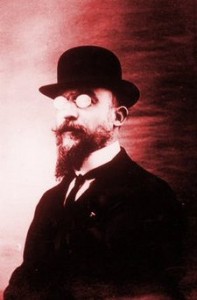1913 was a year of destruction: it saw the beginning of the First World War, and the première of Stravinsky’s Rite of Spring which smashed the homogeny of the orchestra, as well as principles of rhythm and harmony.

But it also witnessed annihilation on a smaller scale: Erik Satie, the master of Arcueil, took on Mozart and destroyed him. Satie turned his satiricial eye on Mozart’s famous Rondo alla turca in his set of three piano pieces forming the Croquis et agaceries d’un gros bonhomme en bois.
Satie’s exaggerated parody in the first of these, his Tyroliene Turque, skewers Mozart harmonically, rhythmically, and structurally.
Satie has introduced strange dissonances into Mozart’s harmonies, and altered the time-signature from Mozart’s original 2/4 to a rhythmic feel of three beats in a bar (although, by this stage, Satie had long abandoned anything so traditional as time-signatures and bar-lines, so the score has neither). The right-hand octaves in Mozart’s piece have been split by Satie, such that the melody is distended further by having each note repeated an octave higher.
And then: the music returns to the opening ostinato, which seems to be in G major, but with a prominent flattened seventh on the third beat of each repetition suggesting that the music may move to C major – which, being Satie, of course it does not. These repeating, endless patterns, implying harmonic motion on the one hand whilst denying it on the other, are typical of Satie: ” listen, I’m going to modulate: oh, wait, no I’m not!”
That’s the great thing about Satie: his music is murderous in a brilliantly concise fashion. Don’t underestimate him: there’s always more to Satie than meets the ear.

One thought on “Turkish Delight: Satie vs Mozart”